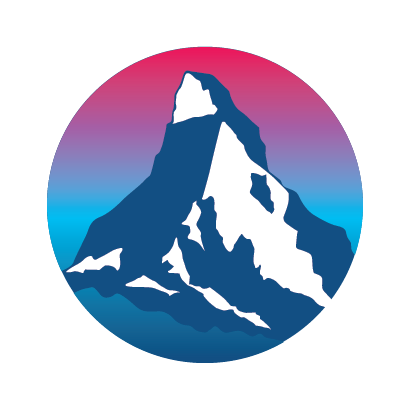The Valais to the French speaker, or Wallis to the German speaker, is an arid canton with many of Europe’s highest, glaciated peaks. Typically, the weather is sunny and dry, making a hiker’s paradise. Numerous trails follow ancient, handbuilt irrigation channels, that cross the hillsides and link farming hamlets and high pastures, or alps, and carry the hiker back in time.
Location and Geography
Zermatt
The Valais is home to the world famous destination of Zermatt. Get sweeping views of the iconic Matterhorn, towering over the quaint, bustling and overbuilt village, blessedly car-free. The name Zermatt comes for the German words Zur Matte for “at the meadow”.
Some touristic destinations are crowded; others are crowded and fabulous. Paris is an example of the latter. So is Zermatt. The hiking is extensive, offers unparalleled scenery and is accessible not only by foot but by a highly developed lift system. Views include the Matterhorn, the Monte Rosa, the Mischabel group and the Gorner Glacier, Europe’s second largest glacier.
Zermatt is well known as a mountaineering and ski resort town. The year-round population of Zermatt is between 5-6,000 but can increase in size considerably any time of the year since it is a popular tourist destination.
Saas Fee
Of course, Zermatt is not the only resort in the Valais. Saas Fee, just over the Mischabel ridge, is another fully developed resort town. Set beneath tumbling glaciers with spectacular mountain views and a full range of hikes, Saas Fee is a slightly sleepier cousin to Zermatt. Two of the Alps’ finest high level walks, the Grachen Hohenweg and the Gspon Hohenweg, terminate in there.
Saas Fee can be reached by car or bus, but neither are allowed inside the city walls. Instead, they must be parked in designated car parks. Small electric vehicles are the only vehicles to operate inside of the city. The decision to minimize traffic was made by the town in 1951 when the road was being built from Saas Grund. In addition to mountaineering and skiing, you can enjoy a range of other activities, including classical music, restaurants, nightclubs, and a sports and leisure complex at Saas Fee.
Lotschental
If you prefer to get more off the beaten path, consider visiting the Lotschental, a valley that time forgot, just north of the Rhone. The tiny villages of Kippel and Wiler offer accommodations and access to the valley’s few peaceful and spectacular hikes. Otherwise, travel into the French-speaking portion of the canton south of the Rhone.
There, the hiker can find unspoiled Valaisian villages with original, blackened timber houses, citizens (especially the older generation) in traditional costume, plenty of miles of untrammeled hiking, and fabulous and unusual views of the snowy, glaciated Pennine Alps.
The villages of Arolla, Les Hauderes, Grimentz and the quirky artist’s colony of St. Luc offer primarily simple accommodations and access to hundreds of miles of good trails: but come prepared with maps and map reading skills!
Must-Have Dish
Käseschnitte! It’s a popular dish of the Valais and Bernese Oberland regions of Switzerland. French speakers call it croûte au fromage.
We’ve often said that Käseschnitte is to toasted bread and cheese what filet mignon is to steak, a divine upgrade. The dish comes in many varieties, but the basic version is nothing more than toasted bread covered with locally available cheese and white wine. The whole thing is broiled and often served with a slice of ham, tomato or both beneath the cheese. The Swiss like to eat Käseschnitte with a fried egg on top, adding cholesterol insult to injury. To order a Käseschnitte straight up, without egg, ask for it “ohne ei” (oh-nah eye).
Käseschnitte is a very warming dish during the winter and a great hiker’s repast during summer. Incidentally, our secret lunch spot between Murren and Wengen serves up some of the best Käseschnitte found anywhere in the Alps.









Comments are closed.